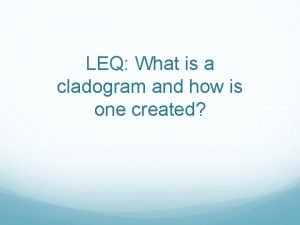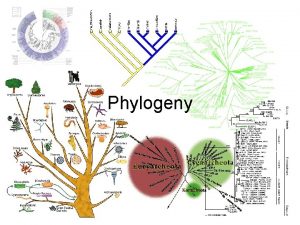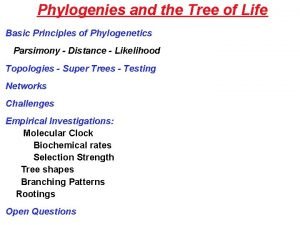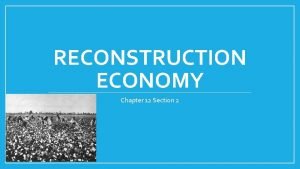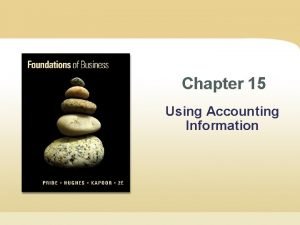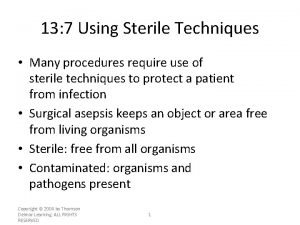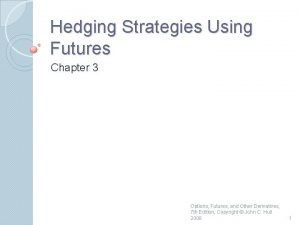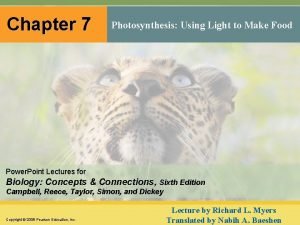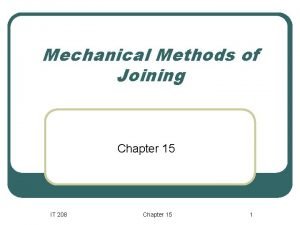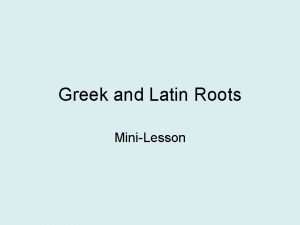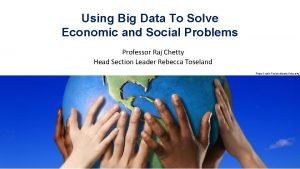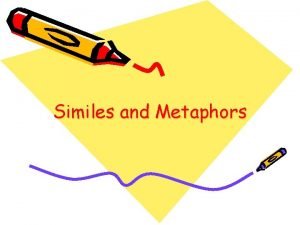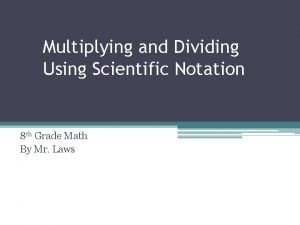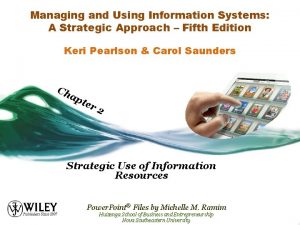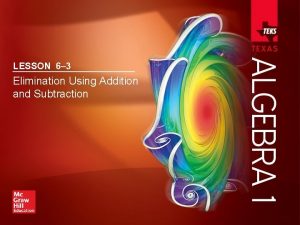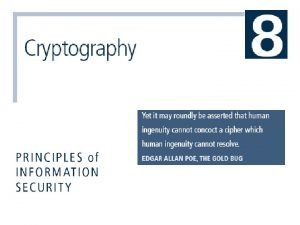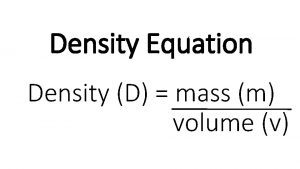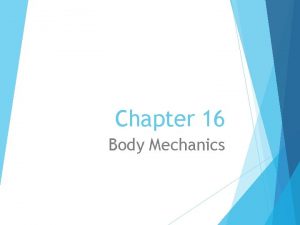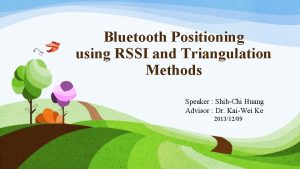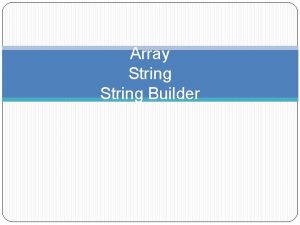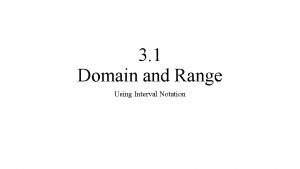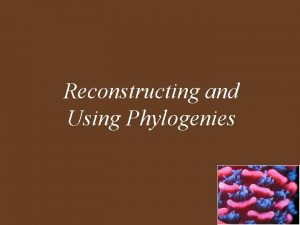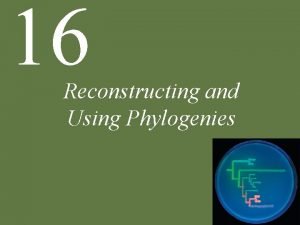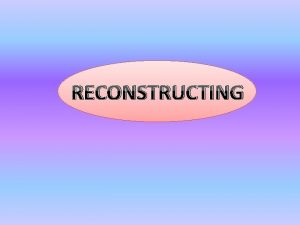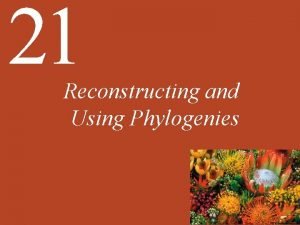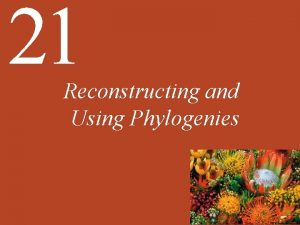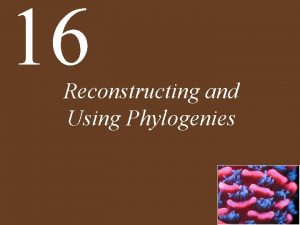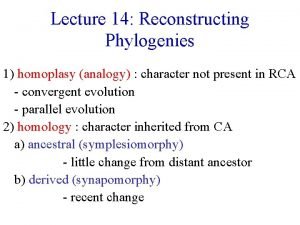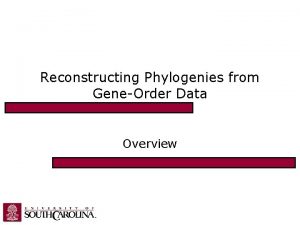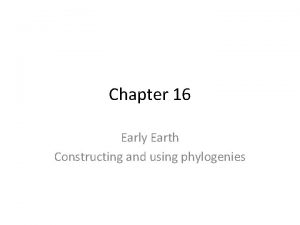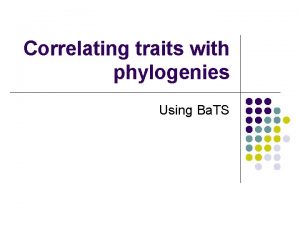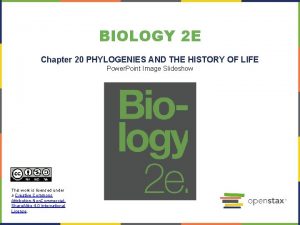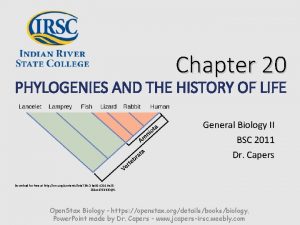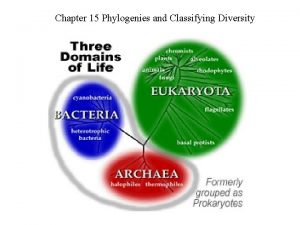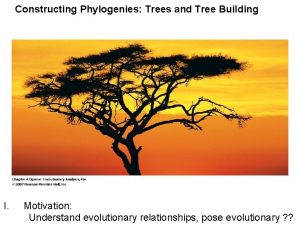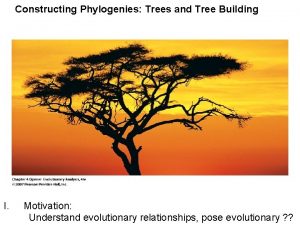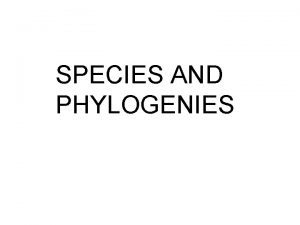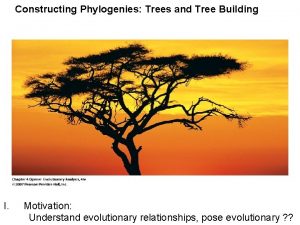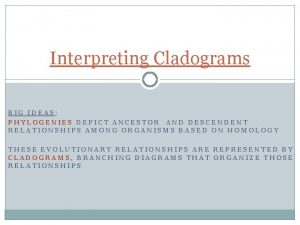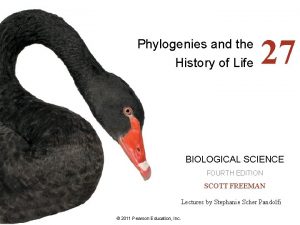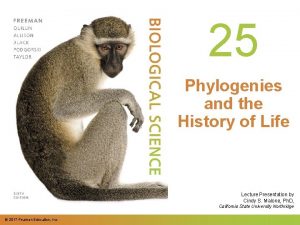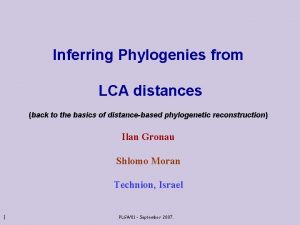16 Reconstructing and Using Phylogenies Chapter 16 Reconstructing






































































- Slides: 70

16 Reconstructing and Using Phylogenies

Chapter 16 Reconstructing and Using Phylogenies Key Concepts 16. 1 All of Life Is Connected through Its Evolutionary History 16. 2 Phylogeny Can Be Reconstructed from Traits of Organisms 16. 3 Phylogeny Makes Biology Comparative and Predictive 16. 4 Phylogeny Is the Basis of Biological Classification

Chapter 16 Opening Question How are phylogenetic methods used to resurrect protein sequences from extinct organisms?

Concept 16. 1 All of Life Is Connected through Its Evolutionary History All of life is related through a common ancestor. This explains why the general principles of biology apply to all organisms. Phylogeny is the evolutionary history of these relationships. A phylogenetic tree is a diagrammatic reconstruction of that history.

Concept 16. 1 All of Life Is Connected through Its Evolutionary History An ancestor and its descendant populations form a lineage, shown as a line drawn on a time axis:

Concept 16. 1 All of Life Is Connected through Its Evolutionary History When a single lineage divides into two, it is depicted as a split or node:

Concept 16. 1 All of Life Is Connected through Its Evolutionary History As the lineages continue to split over time, the history can be represented in the form of a branching tree:

Concept 16. 1 All of Life Is Connected through Its Evolutionary History A phylogenetic tree may portray the evolutionary history of: • All life forms • Major evolutionary groups • Small groups of closely related species • Individuals • Populations • Genes

Concept 16. 1 All of Life Is Connected through Its Evolutionary History The common ancestor of all the organisms in the tree forms the root of the tree:

Concept 16. 1 All of Life Is Connected through Its Evolutionary History The timing of splitting events is shown by the position of nodes on a time axis. The splits represent events such as: • A speciation event (for a tree of species) • A gene duplication event (for a tree of genes) • A transmission event (for a tree of viral lineages) • http: //www. pol 2 e. com/mc 16. 01. html

Concept 16. 1 All of Life Is Connected through Its Evolutionary History Vertical distances between branches do not have any meaning, and the vertical order of lineages is arbitrary.

Concept 16. 1 All of Life Is Connected through Its Evolutionary History Taxon—any group of species that we designate with a name Clade—taxon that consists of all the evolutionary descendants of a common ancestor Identify a clade by picking any point on the tree and tracing all the descendant lineages.

Figure 16. 1 Clades Represent All the Descendants of a Common Ancestor

Concept 16. 1 All of Life Is Connected through Its Evolutionary History Sister species: two species that are each other’s closest relatives Sister clades: any two clades that are each other’s closest relatives

Concept 16. 1 All of Life Is Connected through Its Evolutionary History Before the 1980 s, phylogenetic trees were used mostly in evolutionary biology and systematics—the study and classification of biodiversity. Today trees are widely used in molecular biology, biomedicine, physiology, behavior, ecology, and virtually all other fields of biology.

Concept 16. 1 All of Life Is Connected through Its Evolutionary History Evolutionary relationships among species form the basis for biological classification. As new species are discovered, phylogenetic analyses are reviewed and revised. The tree of life’s evolutionary framework allows us to make predictions about the behavior, ecology, physiology, genetics, and morphology of species.

Concept 16. 1 All of Life Is Connected through Its Evolutionary History Homologous features are: • Shared by two or more species • Inherited from a common ancestor They can be any heritable traits, including DNA sequences, protein structures, anatomical structures, and behavior patterns.

Concept 16. 1 All of Life Is Connected through Its Evolutionary History Each character of an organism evolves from one condition (the ancestral trait) to another condition (the derived trait). Shared derived traits provide evidence of the common ancestry of a group and are called synapomorphies. The vertebral column is a synapomorphy of the vertebrates. The ancestral trait was an undivided supporting rod.

Concept 16. 1 All of Life Is Connected through Its Evolutionary History But similar traits can also develop in unrelated groups. Convergent evolution—when superficially similar traits evolve independently in different lineages

Figure 16. 2 The Bones Are Homologous, the Wings Are Not

Concept 16. 1 All of Life Is Connected through Its Evolutionary History In an evolutionary reversal, a character reverts from a derived state back to an ancestral state. These two types of traits are called homoplastic traits, or homoplasies.

Concept 16. 1 All of Life Is Connected through Its Evolutionary History A trait may be ancestral or derived, depending on the point of reference. Example: Feathers are an ancestral trait for modern birds. • But in a phylogeny of all living vertebrates, they are a derived trait found only in birds.

Concept 16. 2 Phylogeny Can Be Reconstructed from Traits of Organisms To construct a phylogenetic tree: Ingroup—the group of organisms of primary interest. Outgroup—species or group known to be closely related to, but phylogenetically outside of, the group of interest.

Table 16. 1

Concept 16. 2 Phylogeny Can Be Reconstructed from Traits of Organisms A trait that is present in both the ingroup and the outgroup must have evolved before the origin of the ingroup and thus is ancestral for the ingroup. Traits present in only some members of the ingroup must be derived traits.

Figure 16. 3 Inferring a Phylogenetic Tree

Concept 16. 2 Phylogeny Can Be Reconstructed from Traits of Organisms Parsimony principle—the preferred explanation of observed data is the simplest explanation In phylogenies, this means minimizing the number of evolutionary changes that need to be assumed over all characters in all groups. The best hypothesis is one that requires the fewest homoplasies.

Concept 16. 2 Phylogeny Can Be Reconstructed from Traits of Organisms Construction of phylogenetic trees has been revolutionized by computing technology and genome sequencing. Any trait that is genetically determined can be used in a phylogenetic analysis. Evidence comes from studies of morphology, development, the fossil record, behavioral traits, and molecular traits.

Concept 16. 2 Phylogeny Can Be Reconstructed from Traits of Organisms Morphology: presence, size, shape, or other attributes of body parts Phylogenies of most extinct species depend almost exclusively on morphology. Fossils provide evidence that helps distinguish ancestral from derived traits. The fossil record can also reveal when lineages diverged.

Concept 16. 2 Phylogeny Can Be Reconstructed from Traits of Organisms Limitations of using morphology: • Some taxa show few morphological differences. • It is difficult to compare distantly related species. • Some morphological variation is caused by environment.

Concept 16. 2 Phylogeny Can Be Reconstructed from Traits of Organisms Development: Similarities in developmental patterns may reveal evolutionary relationships. Example: The larvae of sea squirts have a notochord, which is also present in all vertebrates. • This similarity is not apparent in adults.

Figure 16. 4 The Chordate Connection

Concept 16. 2 Phylogeny Can Be Reconstructed from Traits of Organisms Paleontology: The fossil record is an important source of information that helps distinguish ancestral from derived traits and timing of lineage splits. Limitations: • Few or no fossils have been found for some groups. • The fossil record for many groups is fragmentary.

Concept 16. 2 Phylogeny Can Be Reconstructed from Traits of Organisms Behavior: Some traits are cultural or learned and may not reflect evolutionary relationships (e. g. , bird songs). Other traits have a genetic basis and can be used in phylogenies (e. g. , frog calls).

Concept 16. 2 Phylogeny Can Be Reconstructed from Traits of Organisms Molecular data: DNA sequences have become the most widely used data for constructing phylogenetic trees. Nuclear, chloroplast, and mitochondrial DNA sequences are used. Information on gene products (such as amino acid sequences of proteins) are also used.

Concept 16. 2 Phylogeny Can Be Reconstructed from Traits of Organisms Mathematical models are now used to describe DNA changes over time. Models can account for multiple changes at a sequence position and different rates of change at different positions. Maximum likelihood methods identify the tree that most likely produced the observed data. They incorporate more information about evolutionary change than do parsimony methods.

Concept 16. 2 Phylogeny Can Be Reconstructed from Traits of Organisms Phylogenetic trees can be tested with computer simulations and by experiments on living organisms. These studies have confirmed the accuracy of phylogenetic methods and have been used to refine those methods and extend them to new applications.

Figure 16. 5 The Accuracy of Phylogenetic Analysis (Part 1)

Figure 16. 5 The Accuracy of Phylogenetic Analysis (Part 2)

Figure 16. 5 The Accuracy of Phylogenetic Analysis (Part 3)

Concept 16. 3 Phylogeny Makes Biology Comparative and Predictive Applications of phylogenetic trees • Reconstructing past events: § § In zoonotic diseases (infections transmitted to humans from another animal), it is important to understand when, where, and how the disease first entered a human population. One example is human immunodeficiency virus (HIV).

Concept 16. 3 Phylogeny Makes Biology Comparative and Predictive § § Phylogenies are important for understanding the present global diversity of HIV and determining the virus’s origins in human populations. Phylogenetic analysis shows that humans acquired HIV-1 from chimpanzees and HIV-2 from sooty mangabeys.

Figure 16. 6 Phylogenetic Tree of Immunodeficiency Viruses

Concept 16. 3 Phylogeny Makes Biology Comparative and Predictive • Forensic investigations that involve viral transmission: § § A physician was accused of injecting blood from an HIV-positive patient into his former girlfriend in an attempt to kill her. Phylogenetic analysis revealed that the HIV strains present in the girlfriend were a subset of those present in the physician’s patient.

Figure 16. 7 A Forensic Application of Phylogenetic Analysis

Concept 16. 3 Phylogeny Makes Biology Comparative and Predictive • Evolution of complex traits: § § Mail swordtail fish with longer tails are more likely to mate successfully. The sensory exploitation hypothesis suggests that female swordtails had a preference for males with long tails even before the tails evolved.

Concept 16. 3 Phylogeny Makes Biology Comparative and Predictive § Phylogenetic analysis identified the closest relatives (Priapella), which do not have swords; but if a sword was attached artificially, females preferred that male.

Figure 16. 8 The Origin of a Sexually Selected Trait

Concept 16. 3 Phylogeny Makes Biology Comparative and Predictive • Revealing convergent evolution: § § § Most flowering plants produce both male and female gametes on the same individual (in pollen and ovules). Self-incompatible species have mechanisms to prevent self-fertilization and must reproduce by outcrossing with another individual. Other species have self-fertilization, or selfing.

Concept 16. 3 Phylogeny Makes Biology Comparative and Predictive § § § Evolution of fertilization mechanisms was examined in the genus Leptosiphon. Phylogenetic analysis shows that selfcompatibility evolved independently three times in the genus. Based on morphological similarities, the three species had been classified as one.

Figure 16. 9 A Portion of the Leptosiphon Phylogeny

Concept 16. 3 Phylogeny Makes Biology Comparative and Predictive • Reconstructing ancestral states: § § Morphology, behavior, or nucleotide and amino acid sequences of ancestral species can be inferred. Example: Opsin proteins (pigments involved in vision) were reconstructed in the ancestral archosaur, and it was inferred that it was probably active at night.

Concept 16. 3 Phylogeny Makes Biology Comparative and Predictive • Molecular clocks: § § § Rates of molecular change are constant enough to predict the timing of lineage splits. A molecular clock uses the average rate at which a given gene or protein accumulates changes to gauge the time of divergence. They must be calibrated using independent data—the fossil record, known times of divergence, or biogeographic dates.

Figure 16. 10 A Molecular Clock of the Protein Hemoglobin

Concept 16. 3 Phylogeny Makes Biology Comparative and Predictive § § § A molecular clock was used to estimate the time when HIV-1 first entered human populations from chimpanzees. The clock was calibrated using biopsy samples taken in the 1980 s and 1990 s, then tested using samples from the 1950 s. The common ancestor of this group of HIV-1 viruses can also be determined, with an estimated date of origin of about 1930.

Figure 16. 11 Dating the Origin of HIV-1 in Human Populations (Part 1)

Figure 16. 11 Dating the Origin of HIV-1 in Human Populations (Part 2)

Concept 16. 4 Phylogeny Is the Basis of Biological Classification The biological classification system was started by Swedish biologist Carolus Linnaeus in the 1700 s. Binomial nomenclature gives every species a unique name consisting of two parts: the genus to which it belongs, and the species name. • Example: Homo sapiens Linnaeus (Linnaeus is the person who first proposed the name)

Concept 16. 4 Phylogeny Is the Basis of Biological Classification Species and genera are further grouped into a hierarchical system of higher categories such as family—the taxon above genus. The family Hominidae contains humans, plus our recent fossil relatives, plus our closest living relatives, the chimpanzees and gorillas.

Concept 16. 4 Phylogeny Is the Basis of Biological Classification • Families are grouped into orders § Orders into classes o Classes into phyla (singular phylum) Ø Phyla into kingdoms The ranking of taxa within the Linnaean classification is subjective.

Concept 16. 4 Phylogeny Is the Basis of Biological Classification Linnaeus recognized the hierarchy of life, but he developed his system before evolutionary thought had become widespread. Biologists today often name taxa without placing them into the various Linnaean ranks. Evolutionary relationships are the basis for distinguishing, naming, and classifying biological groups.

Concept 16. 4 Phylogeny Is the Basis of Biological Classification Taxa should be monophyletic—containing an ancestor and all descendants of that ancestor, and no other organisms (a clade). A true monophyletic group can be removed from a phylogenetic tree by a single “cut. ”

Figure 16. 12 Monophyletic, Polyphyletic, and Paraphyletic Groups

Concept 16. 4 Phylogeny Is the Basis of Biological Classification But detailed phylogenetic information is not always available. Polyphyletic—a group that does not include its common ancestor Paraphyletic—a group that does not include all the descendants of a common ancestor These groups are inappropriate as taxonomic units because they do not correctly reflect evolutionary history.

Concept 16. 4 Phylogeny Is the Basis of Biological Classification Codes of biological nomenclature: • Biologists around the world follow rules for the use of scientific names, to facilitate communication and dialogue. • There may be many common names for one organism, or the same common name may refer to several species. But there is only one correct scientific name.

Figure 16. 13 Same Common Name, Not the Same Species

Concept 16. 4 Phylogeny Is the Basis of Biological Classification Historically, scientists working with different groups of organisms developed different rules for classification, and sometimes name duplications occurred. • Example: Drosophila is a genus of fruit flies and a genus of fungi. Today, biologists are working on a universal code of nomenclature that can be applied to all organisms.

Chapter 16 Answer to Opening Question Biologists can reconstruct DNA and protein sequences of a clade’s ancestors if there is enough information about the genomes of their descendants. Real proteins that correspond to proteins in long -extinct species can be reconstructed. These techniques were used to reconstruct fluorescent proteins from the extinct ancestors of modern corals.

Figure 16. 14 Evolution of Fluorescent Proteins of Corals

Chapter 16 Answer to Opening Question These methods rely on mathematical models that incorporate: • Rates of replacement among different amino acid residues • Substitution rates among nucleotides • Changes in the rate of molecular evolution among different lineages
 Lancelet lamprey tuna salamander turtle leopard cladogram
Lancelet lamprey tuna salamander turtle leopard cladogram Building vocabulary: phylogenies
Building vocabulary: phylogenies Phylogenies
Phylogenies Chapter 12 section 2 reconstructing society
Chapter 12 section 2 reconstructing society Chapter 12 section 2 reconstructing society
Chapter 12 section 2 reconstructing society System.collections.generics
System.collections.generics Accumulator ac
Accumulator ac Chapter 15 using management and accounting information
Chapter 15 using management and accounting information Chapter 11 section 4 using water wisely answer key
Chapter 11 section 4 using water wisely answer key We think we are using water wisely because
We think we are using water wisely because Chapter 23 using recipes
Chapter 23 using recipes Chapter 15:5 sterilizing with an autoclave
Chapter 15:5 sterilizing with an autoclave Chapter 14:2 preventing accidents and injuries
Chapter 14:2 preventing accidents and injuries Unit 2 body mechanics
Unit 2 body mechanics Chapter 20:3 puncturing the skin to obtain capillary blood
Chapter 20:3 puncturing the skin to obtain capillary blood Principles of recipe development
Principles of recipe development Chapter 15:4 observing standard precautions
Chapter 15:4 observing standard precautions Chapter 23 using recipes answer key
Chapter 23 using recipes answer key Chapter 15:8 using sterile techniques
Chapter 15:8 using sterile techniques Tailing a hedge
Tailing a hedge Chapter 7 photosynthesis using light to make food
Chapter 7 photosynthesis using light to make food Using effective promotions
Using effective promotions Chapter 14:4 observing standard precautions
Chapter 14:4 observing standard precautions This chapter shows how vectors can be added using
This chapter shows how vectors can be added using Chapter 15:4 observing standard precautions
Chapter 15:4 observing standard precautions Chapter 6:2 using medical abbreviations
Chapter 6:2 using medical abbreviations Chapter 15 using fasteners
Chapter 15 using fasteners Glencoe health chapter 19 medicines and drugs
Glencoe health chapter 19 medicines and drugs Using greek and latin roots and affixes
Using greek and latin roots and affixes Compare and contrast p waves and s waves using venn diagram
Compare and contrast p waves and s waves using venn diagram Chapter 7 ionic and metallic bonding chapter answer key
Chapter 7 ionic and metallic bonding chapter answer key Chapter 7 ionic and metallic bonding chapter answer key
Chapter 7 ionic and metallic bonding chapter answer key Properties of ionic compounds
Properties of ionic compounds Chapter 7 chapter assessment ionic compounds and metals
Chapter 7 chapter assessment ionic compounds and metals Dichlorine octoxide formula
Dichlorine octoxide formula Discusses advantages and disadvantages
Discusses advantages and disadvantages 6-3 elimination using addition and subtraction
6-3 elimination using addition and subtraction Using recursion in models and decision making
Using recursion in models and decision making Using functions in models and decision making
Using functions in models and decision making Using risk to balance agile and plan driven methods
Using risk to balance agile and plan driven methods Using big data to solve economic and social problems
Using big data to solve economic and social problems What is the study or art of using language effectively?
What is the study or art of using language effectively? Solving systems using tables and graphs
Solving systems using tables and graphs Solving equations using addition and subtraction
Solving equations using addition and subtraction Cons of skype
Cons of skype Similes and metaphors poems
Similes and metaphors poems Deduce the resultant of two parallel forces
Deduce the resultant of two parallel forces Using mathematics and computational thinking
Using mathematics and computational thinking Make sentences using the past simple and past continuous
Make sentences using the past simple and past continuous Opportunities in media and information examples
Opportunities in media and information examples Scientific notation rules
Scientific notation rules Coordinate proof using slope and distance
Coordinate proof using slope and distance People media characteristics
People media characteristics How to find volume density and mass
How to find volume density and mass Managing and using information systems
Managing and using information systems 6-3 elimination using addition and subtraction
6-3 elimination using addition and subtraction Cryptovariable
Cryptovariable What is health and safety in ict
What is health and safety in ict Hcf and lcm worksheet
Hcf and lcm worksheet Tiling problem using divide and conquer algorithm
Tiling problem using divide and conquer algorithm How to find mass with density and volume
How to find mass with density and volume Finding and using negotiation power
Finding and using negotiation power Lesson 6: cardiac emergencies and using an aed
Lesson 6: cardiac emergencies and using an aed When using monomer liquid and polymer powder, you:
When using monomer liquid and polymer powder, you: Presenting insights and findings using written reports
Presenting insights and findings using written reports Using the body in an efficient and careful way is
Using the body in an efficient and careful way is Buying and disposing consumer behavior
Buying and disposing consumer behavior Bluetooth positioning using rssi and triangulation methods
Bluetooth positioning using rssi and triangulation methods Jagged array
Jagged array 6-3 elimination using addition and subtraction answer key
6-3 elimination using addition and subtraction answer key Domain using interval notation
Domain using interval notation
